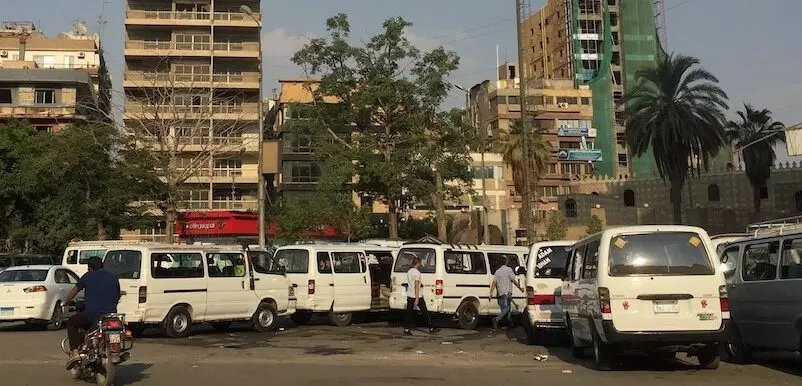Microbuses–those white and blue minivans you see driving chaotically in the streets of Cairo. Once you become familiar with them, you won’t ride anything but them. Microbuses are the cheapest and quickest way to travel across Cairo. Of course, like anything else, they have their pros and cons. But if you want to taste the Egyptian lifestyle to the fullest, they’re a must.
Table of Contents
What are they even?
Microbuses are nongovernmental means of transport in Cairo. We have buses, the metro (subway), and taxis, but how do you connect those areas where there are no buses or metro stations? Exactly! Microbuses. There are no specific stops for microbuses as there are for buses. They pick you up from anywhere on the street and drop you off wherever you want. They are mostly white and blue… or just white. Think of the microbus as a shared Uber, but a very Egyptian one.
(Fun fact: Uber Egypt has recently launched “Uber Bus,” which is basically the same as a microbus but you hail it through an app. But in my opinion, you’ll hardly need it. You can find microbuses everywhere.)
Catching a Ride
Let’s say you want to go to Tahrir Square. You first need to know whether there are microbuses from where you are standing that are heading to Tahrir Square or not. So you can ask any bystander before you ride fī mikrubaʂāt min hína li-midān ittaɧrīr? فيه ميكْروباصات مِن هِنا لِميدان التّحْرير؟ Are there any microbuses from here to Tahrir Square? But for peace of mind, ask two or three bystanders–because there is always a high probability of getting the wrong information. That’s tip number one!
Now that you know that microbuses are passing by that are going where you want to go, it’s time to take the first step to become an honorary Egyptian by waving your hand at a driver. Or just even maintain awkward eye contact for two or three seconds; he’ll automatically stop but not necessarily right in front of you–maybe a few steps ahead, or in the middle of the road. You never know. Don’t worry. He knows what he’s doing. Then you tell him where you want to go. If he says ta3āla! تعالَى Come! or írkab! اِرْكب Get in! or just nods in your general direction, then congratulations! You just got your first microbus in Cairo!
Paying the Fare
After you get in, you’ll need to ask about the fare to your specific destination, as it may vary in the same microbus depending on where you are getting off. So, for our Tahrir Square example, after you get on, ask the driver or any passenger next to you ilʔúgra kām li-midān ittaɧrīr الأُجْره كام لِميدان التّحْرير؟ What’s the fare to Tahrir Square? And here comes the interesting part: How does the money reach the driver?
Let’s say the fare is 2.5 pounds, but you don’t have the exact change, only a 5-pound bill. You pass the bill to the person in front of you saying wāHid min ilxámsa midān ittaɧrīr واحِد مِن الخمْسه ميدان التّحْرير One fare for Tahrir Square from the 5 pounds. That person will pass it up repeating the same sentence until it reaches the driver, who will then pass the change back the same way it was passed up to him until it reaches you. And don’t worry. It will reach you. But in case the driver doesn’t give you the change within a few minutes, you should shout bāʔi -lxámsa wára yásʈa! باقى الخمْسه وَرا ياسْطا Pass the change for the five pounds back, driver! to remind him. Another possibility would be that the nice person sitting beside you has the exact fare and hasn’t paid yet. So you take the 2.5 pounds from them to keep and pass your 5-pound bill forward saying itnēn min ilxámsa اِتْنيْن مِن الخمْسه Two fares from the five pounds.
After you’ve finished the whole affair concerning the fare, remember to remind anyone riding with you to tell you when your stop is coming up if you don’t already know it. And as you approach, you’ll need to announce in a loud voice 3ála gambə yásʈa! علَى جنْب ياسْطا Pull over here, driver! And remember, he might stop in the middle of the road, so beware of traffic when getting out.
Once you’re more familiar with microbuses, you’ll notice a kind of secret sign language between potential passengers and drivers. They simply make a sign with their hands and the driver stops and they get in without saying a word. What is this?!
Hand Signals: Cracking the Enigma
There are hand gestures that passengers and drivers use that indicate specific destinations. You’ll start to learn them after a couple rides on the same route. They’re actually quite logical and intuitive.
The signs come either from the meaning of the destination or its indication. For example, if you are going to the beginning of a major road, you can sign by raising your index finger on one hand, which means áwwil iššāri3 اوِّل الشّارِع the beginning of the street. (The association in Arabic is clear because the word áwwil اوِّل beginning also means first (i.e., number one).
Another example: If you are standing along the microbus route to the Pyramids area, the sign would be pointing your index and middle finger downward (which makes the shape of a triangle (or pyramid) with a missing base).
However, for these signs to be relevant, you must be standing either along the route of the microbuses going to those places, or at least in the area where those microbuses go around. It’s also important to note that one hand gesture can indicate different destinations depending on the place. If you are not sure and don’t want to find yourself in the middle of nowhere, ask the driver before you get in.
There are lots and lots of those signs on every route and in every area. How can you get to know them all? Well, of course, you don’t need to know them all. But you will pick up the ones useful to you if you watch the driver and passengers on the street your microbus approaches. Just don’t make up your own signs hopefully the driver will “get” what you’re implying! You’ll get a confused look. So notice others using a hand signal first, understand and mimic it.
The Major Microbus Stations of Greater Cairo (Cairo and Giza)
This is all for when you’re standing along the route. Of course, you might also be taking a microbus from its departure station–the crowded, noisy place where every driver is yelling his destination. You won’t have to gesture your destination here or hail a driver to stop. You’ll just need to find where the microbuses line up for your route and wait to fill up with passengers.
Ramses Microbus Station
máwʔaf ramsīs مَوْقف رمْسيس is located in Ramses Square in front of the only train station in Cairo (Ramses Train Station). This specific stop is like the International Space Station. It’s magnificent! You can go almost anywhere inside or outside Cairo from here. Or in the worst cases, you can at least take a microbus from here to another stop where you can get a microbus to your final destination.
Abdel Moneim Riad Microbus Station
máwʔaf 3abd ilmún3am riyāɖ مَوْقف عبْد المُنْعم رِياض is just behind the Egyptian Museum near Tahrir Square. It is the second most important microbus station as it connects the two cities of Cairo (east of the Nile) and Giza (west of the Nile).
Giza Microbus Station
máwʔaf iggīza مَوْقف الجّيزه lies in Giza Square. Here you can find microbuses heading for the western part of Giza and Giza in general, so if you decide to travel like an Egyptian (a.k.a. taking a microbus) to go visit the Pyramids, it’s the station you’ll need.
El’Asher Microbus Station
máwʔaf il3āšir مَوْقف العاشِر is found along the Ring Road connecting the eastern part of Cairo with the western part. From here, you can get to more remote areas east of Cairo, such as Al Oboor and El Shorouk City.
Alf Maskan Microbus Station
máwʔaf alfə máskan مَوْقف الْف مسْكن is in Alf Maskan Square. It is one of the most important stations as it is right in the middle of Cairo, connecting everywhere with everywhere inside Cairo.
All these stations are always crowded, a bit chaotic, so keep your eye on your belongings so you don’t fall victim to pickpocketing, especially if you look like a tourist.
All these stations are always crowded, a bit chaotic, so keep your eye on your belongings so you don’t fall victim to pickpocketing, especially if you look like a tourist.
Anatomy of the Microbus
So after you’ve gotten to know the stations, the hand signs, and how to travel through Cairo, there is one crucial part missing: Where to sit inside the microbus? How to pick your seat? Any seat will do, but not all seats are created equal. It’s worth taking a few things into consideration, especially if your journey is long and you don’t want to be bothered.
The microbus has 14 seats–two in the front beside the driver and four rows of bench seats. Each row seats three people. So where should you sit when given a choice?
Where to Sit
If you are the kind of a person who would rather not be bothered during your journey, the lefthand seat in the back row beside the window is absolutely the perfect seat for you, especially if you are getting off at the end of the route. You’ll enjoy the breeze with your headphones on and never bothered having to collect fares for the driver. (In some other seats, you are almost guaranteed to have to do this for the whole microbus and pass back change. We’ll get to that).
If you prefer comfort over all else and want to shoot a video or take nice photos of the road, of course, ride shotgun and pay for the two “royal” seats beside the driver. (You don’t necessarily have to pay for both seats, but if you do, no one will sit next to you.) It might also be an excellent opportunity to practice your language skills with the driver, as the driver is very likely to start a conversation with you.
The righthand seat in the back row is good, too. You won’t be bothered by collecting the fares or anything, but there is a slight probability of you, gentlemen, having to slide over to the middle of the bench so a woman getting on can sit on the right side. Why? If all other seats are taken, you should not make a lady sit in a tight spot between two men, so either you slide over yourself, or most likely she will say to you ba3də íznak, múmkin tídxul gúwwa? بعْد اِذْنك مُمْكِن تِدْخُل جُوّا؟ Could you please move over? (There are lots of harassment incidents that happen on microbuses, so women prefer not to sit between two men, especially in the back row.)
Where Not to Sit
There are three seats to avoid if you can. The first is the middle seat in the first row behind the driver. This is the “accountant’s” seat. All of the fares being passed up will go through you. You’ll also have to pass back change, remember how many passengers are getting off at which stop if the fares are different. It’s a real pain–only for expert microbus riders. And why can’t you just give the money to the driver to calculate? I don’t know. Nobody does. It’s understood to be the responsibility of the person sitting in the “accountant’s” seat. Sometimes, when you pass up the fares one by one to the driver, he’ll refuse them and say úgra má3a ba3ɖ اُجْره معَ بعْض the fare altogether, which really means, “You decent people behind me, organize all the fares, then give them to me all at once.” So don’t make the rookie mistake of sitting in that spot! You’ll regret it!
The second and third regrettable seats are the two folding chairs on the right of the second and third bench rows, especially the second one near the door. You’ll have to get off the microbus for any one of the six passengers behind you and the two beside you when they get off. The same problem goes for the third folding chair to the right of the third bench row. You’ll have to make room for the five passengers beside and behind you when they are getting off.
In Conclusion
So, pros and cons? You already know them by now. Microbuses are the quickest and cheapest way to get from one place to another. Drivers always take shortcuts to get you to the destination. It’s like a race for them–more trips, more money–so reckless driving is something you should get used to after a few trips. (I mean, what’s the worst that could happen?) And if you are going down the craziest, most chaotic street, it’s better to be riding with the most talented, crazy, chaotic drivers out there.









very informational! First time I have read about these hand signs haha.